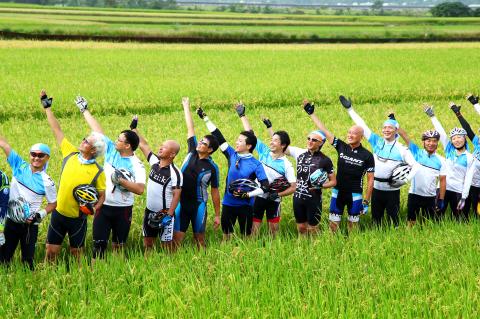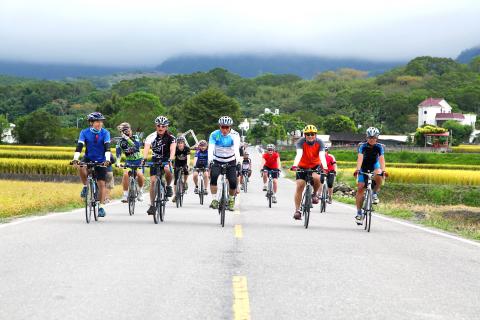Roads might appear perfectly flat when you drive down them in the comfort of your car. But they’re not. Almost every road angles either up or down, and when in the midst of a long-term cycling trip, you notice every minute degree. Even the slightest downward slope elicits a feeling of pure euphoria, while the smallest rise in elevation can be enough to crush your soul.
All of this became clear to me during my first long-distance bicycle trip, the Formosa 900 (騎遇福爾摩沙), a 900-kilometer-plus, nine-day, two-wheel trek around Taiwan designed to cultivate a cycling culture on the island from the ground up.
Giant Bicycles CEO Tony Lo (羅祥安) took part in the trip, doing his fifth ride around the island. Also along in my riding group were politicians and bike industry representatives, each looking to curry favor with the other in the interest of boosting tourist numbers, increasing the sales of Taiwan-made bikes and related components, getting more locals to see Taiwan from the seat of a bike and ostensibly helping the environment.

Photo courtesy of the Cycling Lifestyle Foundation
TALE OF TWO ENVIRONMENTS
Cycling in Taiwan is really a tale of two environments, those of the eastern and western halves of the island. The only thing the two have in common is that they’re both in Taiwan, though biking through them you would be forgiven for thinking they are two different worlds: one an idyllic place of uncommon natural beauty, the other the former’s unregulated dumping ground.
My team’s journey from north to south would take us down the eastern side of Taiwan, mostly via the valley between the Central and Coastal Mountain Ranges, from Taipei City all the way to the town of Checheng (車城) in Pingtung County. After a few words of encouragement from Taipei City Mayor Hau Lung-bin (郝龍斌) on the morning of Nov. 9, we were on our way, with Hau himself leading us partway through the city on a uBike, a public bike program put forth to get the city pedaling.

Photo courtesy of the Cycling Lifestyle Foundation
From the outset, a gradual climb of nearly 1,000 meters as we moved from New Taipei City toward Yilan County had my legs pumping battery acid. By the time we reached the Shipai (石牌) Barrier, a thick fog had settled over the peak and a bitter late-fall cold had set in. A murderous headwind did little to ease the feeling that I might have to do the train ride of shame back home to Taipei. But after a few hours we reached the summit, and the climb gave way to a blissful downhill roll. The flooded rice paddies and whitecap surf of Yilan County came into view, and we coasted down the steep, smooth switchback toward the hot spring town of Jiaoxi (礁溪).
The beautiful scenery of the eastern half of Taiwan would continue through Hualien County, on to Taitung and finally to Pingtung before we would make the swing northward. At times my legs were as stiff as two-by-fours as we covered an average of 100 kilometers daily, but the sights always made the pain worthwhile. The ride to the town of Zhiben (知本) passed through bucolic fields and verdant valley scenery, with farmers bringing in their crops as we rolled by.
THE LOST WEST
Unfortunately, the inspirational sight would be the last thing of beauty we would see for quite some time. The trip from south to north along the western coast of the island is largely urban and industrial blight, kilometer after mind-numbing lung-blackening kilometer.
On the ride to Kaohsiung, my white cycling jersey turned a sickly shade of gray, and later that night I watched a day’s worth of chemical grit and exhaust fumes trickle down the shower drain. Kaohsiung has made a much publicized effort to clean up its act in recent years, but a paradise for cyclists its surrounding environs definitely is not. What few riders there were who dared to bike past the region’s collection of factories and warehouses were forced to share busy roads clogged with smoke blasting eighteen-wheelers and all manner of other vehicles rushing by. By the time we reached Taichung, we were growing tired of chewing up kilometer after kilometer of flat highway between interchangeable urban centers, and nighttime beverages with touring mates took on a grim, funerary fugue. But the camaraderie we built during these times was real, and if it was the dreariness of our surroundings that brought this out, I guess we have that to thank for it.
Will cycling become a lasting passion in Taiwan? The bike industry certainly seems to have the government’s ear, and vice versa, and the yearly Taiwan Cycling Festival (臺灣自行車節) held each November is a good start. What’s more, the bicycle business in Taiwan couldn’t hope for a more able and charismatic spokesman than Tony Lo. At every stop along the way, it was as though we were traveling with a rock star—a bicycle evangelist out to convert the masses. Groups of cyclists spotted his trademark shaved head and flashy smile and jaunted over for a kind word, and he was all too happy to oblige.
The main barrier to drawing foreign tourists is the fact that there are simply some parts of Taiwan that you couldn’t pay your average European cycling enthusiast to bike through. There are only a few stretches along the western side of the island on the route following the main highways and county roads we took on the Formosa 900 that are even remotely interesting from a visual perspective. Much of it is downright unsightly. During the ride to Kaohsiung, a comment from a member of the European press corps summed up the western portion of the trip accurately when he said, “At least they’re not hiding the ugly parts.”
Conversely, there are areas on the eastern side of Taiwan offering scenery the likes of which the rest of the world would find difficult to top. Perhaps the answer is to promote those places that already have that visual appeal, while trying to find a way to clean up areas which aren’t there yet. In any case, the cycling paths of Taipei were jam-packed on our ride through the city on that final day. Taiwan is in the formative stages of getting on two non-mechanized wheels, and increasing sales from the likes of Giant prove it. But steps will have to be taken in order to keep them there. You can only pass over the same old paths so many times before the next fad comes along to steal your attention away.

The canonical shot of an East Asian city is a night skyline studded with towering apartment and office buildings, bright with neon and plastic signage, a landscape of energy and modernity. Another classic image is the same city seen from above, in which identical apartment towers march across the city, spilling out over nearby geography, like stylized soldiers colonizing new territory in a board game. Densely populated dynamic conurbations of money, technological innovation and convenience, it is hard to see the cities of East Asia as what they truly are: necropolises. Why is this? The East Asian development model, with

June 16 to June 22 The following flyer appeared on the streets of Hsinchu on June 12, 1895: “Taipei has already fallen to the Japanese barbarians, who have brought great misery to our land and people. We heard that the Japanese occupiers will tax our gardens, our houses, our bodies, and even our chickens, dogs, cows and pigs. They wear their hair wild, carve their teeth, tattoo their foreheads, wear strange clothes and speak a strange language. How can we be ruled by such people?” Posted by civilian militia leader Wu Tang-hsing (吳湯興), it was a call to arms to retake

This is a deeply unsettling period in Taiwan. Uncertainties are everywhere while everyone waits for a small army of other shoes to drop on nearly every front. During challenging times, interesting political changes can happen, yet all three major political parties are beset with scandals, strife and self-inflicted wounds. As the ruling party, the Democratic Progressive Party (DPP) is held accountable for not only the challenges to the party, but also the nation. Taiwan is geopolitically and economically under threat. Domestically, the administration is under siege by the opposition-controlled legislature and growing discontent with what opponents characterize as arrogant, autocratic

When Lisa, 20, laces into her ultra-high heels for her shift at a strip club in Ukraine’s Kharkiv, she knows that aside from dancing, she will have to comfort traumatized soldiers. Since Russia’s 2022 invasion, exhausted troops are the main clientele of the Flash Dancers club in the center of the northeastern city, just 20 kilometers from Russian forces. For some customers, it provides an “escape” from the war, said Valerya Zavatska — a 25-year-old law graduate who runs the club with her mother, an ex-dancer. But many are not there just for the show. They “want to talk about what hurts,” she